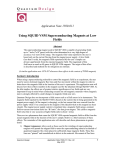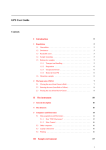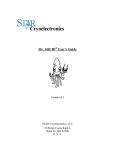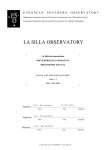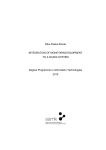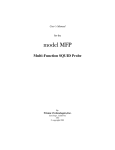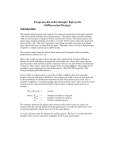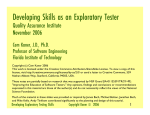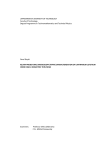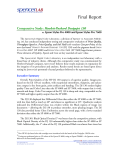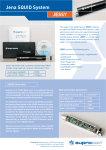Download Initialization of Cryogenic S600X Magnetometer
Transcript
LAPPEENRANTA UNIVERSITY OF TECHNOLOGY FACULTY OF TECHNOLOGY LUT ENERGY DEPARTMENT OF ELECTRICAL ENGINEERING Bachelor’s Thesis Initialization of Cryogenic S600X Magnetometer Aki Pulkkinen 26.3.2010 Supervisor: prof. Erkki Lähderanta Contents 1 Introduction 3 2 Operation of an RF SQUID magnetometer 3 2.1 Josephson junction . . . . . . . . . . . . . . . . . . . . . . . . . . . . 3 2.2 Flux quantization . . . . . . . . . . . . . . . . . . . . . . . . . . . . . 4 2.3 Tank circuit and hysteretic behaviour . . . . . . . . . . . . . . . . . . 4 2.4 Flux-locked operation . . . . . . . . . . . . . . . . . . . . . . . . . . . 7 2.5 Flux transformer . . . . . . . . . . . . . . . . . . . . . . . . . . . . . 8 3 Cryogenic S600X magnetometer 3.1 Lake Shore 340 temperature controller . . . . . . . . . . . . . . . . . 3.1.1 8 9 Initialization . . . . . . . . . . . . . . . . . . . . . . . . . . . . 11 3.2 SCU 500 SQUID electronics . . . . . . . . . . . . . . . . . . . . . . . 12 3.3 Data acquisition system (DAS) . . . . . . . . . . . . . . . . . . . . . 12 3.4 Cryogenic HLG 200 helium level gauge . . . . . . . . . . . . . . . . . 12 3.5 Computer . . . . . . . . . . . . . . . . . . . . . . . . . . . . . . . . . 13 3.6 Cryogenic SMS 80C magnet power supply . . . . . . . . . . . . . . . 13 3.6.1 Initialization . . . . . . . . . . . . . . . . . . . . . . . . . . . . 13 3.7 Valve block control unit . . . . . . . . . . . . . . . . . . . . . . . . . 14 3.8 Electronic filter unit . . . . . . . . . . . . . . . . . . . . . . . . . . . 15 3.9 Oven . . . . . . . . . . . . . . . . . . . . . . . . . . . . . . . . . . . . 15 3.10 Cryostat . . . . . . . . . . . . . . . . . . . . . . . . . . . . . . . . . . 15 3.11 Software . . . . . . . . . . . . . . . . . . . . . . . . . . . . . . . . . . 16 3.11.1 Initialization . . . . . . . . . . . . . . . . . . . . . . . . . . . . 16 3.12 Sample moving mechanism . . . . . . . . . . . . . . . . . . . . . . . . 18 3.12.1 Initialization . . . . . . . . . . . . . . . . . . . . . . . . . . . . 18 4 Summary 18 References 20 Appendix I Symbols and abbreviations Symbols e Elementary charge h Planck’s constant ~ Planck’s constant, h/2π i Current ic Critical current irf Radio frequency current is Tunnelling current Li Input coil inductance Ls SQUID loop inductance Lt Tank circuit inductance Mi,s Mutual inductance of input coil and SQUID loop Mt,s Mutual inductance of tank circuit and SQUID loop Vdc DC voltage Vt Tank circuit voltage ∆φ Deviation of flux from operation point ∆ϕ Phase difference ν Frequency Φ0 Magnetic flux quantum Φext External magnetic flux Abbreviations AC Alternating Current DAS Data Acquisition System DC Direct Current DIP Dual In-line Package LED Light Emitting Diode RAM Random Access Memory RF Radio Frequency SERF Spin Exchange Relaxation-Free SQUID Superconducting QUantum Interference Device VI Virtual Instrument VTI Variable Temperature Insert 1 Introduction The work of B. D. Josephson led to the invention of Superconducting QUantum Interference Devices (SQUIDs) at Ford Research Laboratories in the mid-1960s. The first to be invented was the direct current (DC) SQUID which was soon to be followed by the radio frequency (RF) SQUID [1]. Though the DC SQUID was developed first, and still offers the highest sensitivity, RF SQUIDs are widely used because of their simpler structure and lower manufacturing costs. Strictly speaking, the term ’quantum interference device’ refers to the working principle of a DC SQUID, but the same term is used for its RF counterpart as well. Since their invention, SQUID devices have been the most sensitive magnetometers, allowing the measurement of magnetic flux changes less than the magnetic flux quantum Φ0 . However, the Spin Exchange Relaxation-Free (SERF) magnetometer developed in the early 2000s has reached competitive sensitivity [2]. This work concentrates on the operation of a hysteretic RF SQUID magnetometer, and the structure and initialization of the Cryogenic S600X SQUID magnetometer, located in the physics laboratory of Lappeenranta University of Technology. 2 Operation of an RF SQUID magnetometer RF SQUIDs are based on a ring of superconducting material containing a weak link, e.g. a Josephson junction. 2.1 Josephson junction A Josephson junction consists of two superconductors separated by a thin insulating layer. If the layer is thin enough, Cooper pairs can tunnel through it. Electron-pair waves have different phases at each side of the junction, though the phases are coupled because of tunnelling. The tunnelling current has a maximum value when the phase difference ∆φ = π2 . A Josephson junction is a special case of a weak link between superconductors, in which the dependence of the tunnelling supercurrent 3 is from the phase difference is sinusoidal, as in equation (1) is = ic sin (∆φ) , (1) where ic is the critical current of the junction. Equation (1) defines the DC Josephson effect, in which the tunnelling supercurrent flows without a voltage across the junction, which means that the whole system is in the superconducting state. If a DC current i > ic is fed through the junction, a DC voltage Vdc will exist across the junction. The tunnelling current now has an oscillatory behaviour; the tunnelling current oscillates back and forth through the junction with an amplitude ic . The frequency of the current is given by ν= 2e Vdc . h (2) The small voltage component, with a frequency ν, can be observed in the voltage across the junction. This phenomenon is called the AC Josephson effect [3]. 2.2 Flux quantization Because of the Meissner effect, magnetic flux inside a superconductor is cancelled by screening currents. However, magnetic flux can exist in a superconducting ring, but only if the flux produced by screening currents is such that the total flux inside the ring is quantized. The flux threading the ring is an integral multiple of the magnetic flux quantum Φ0 , which is defined by Φ0 = 2.3 h ≈ 2,0678 · 10−15 Wb. 2e (3) Tank circuit and hysteretic behaviour In an RF SQUID, the superconducting loop couples inductively to the tank circuit, which is driven at a constant current at its resonance frequency, typically from 20 MHz to 30 MHz. The coupling changes the circuit’s resonance frequency and thus the voltage across it. Because of the coupling, the magnetic flux inside the 4 SQUID loop also changes with the driving frequency of the tank circuit. Figure 1 shows a schematic diagram of the arrangement. irf Lt Ls Vt Mt,s Figure 1. SQUID loop and tank circuit. Mt,s is the mutual inductance of SQUID loop and tank circuit and Ls is the inductance of the SQUID loop (∼ 10−9 H) [4]. Applied external flux Φext as a function of total flux Φ is given by Φ , Φext = Φ + Ls ic sin 2π Φ0 (4) where Ls is the inductance and ic the critical current of the SQUID loop. Total flux as a function of applied flux can be determined from equation 4. If 2πLs ic /Φ0 ≥ 1 the dependence Φ (Φext ) is multivalued for some range of Φext . If Φext is swept at a large enough amplitude, hysteretic jumps will occur and cause a dissipation of energy. The hysteretic behaviour is shown in figure 2 with Ls ic /Φ0 = 1. If the total flux is initially Φ = 0 and Φext is swept at an amplitude in the range of Φ1 ≤ Φext ≤ Φ2 , the traced hysteresis loop is A→B→C→D→E→F→G→H→A as shown in figure 2. The hysteretic loss reduces the RF flux coupled to the SQUID loop during the next RF cycle. Thus, no hysteresis loops are traced until the tank circuit has gained enough energy, which may take several cycles. However, if the current irf is increased, the tank ciruit recovers at a faster rate until a current level is reached where the hysteresis loop is traced at every RF cycle. This leads to plateaus in the dependence of the tank circuit voltage Vt from the current irf driving the tank circuit. The plateau begins as the current reaches the value at which hysteretic behaviour begins and ends as the hysteresis loop is traced during every RF cycle. Typically the operating point of the RF SQUID is set at the center of a plateau [5], [6]. 5 Φ/Φ0 B 1 C A H −2 1 Φ1 D E 2 Φ2 Φext /Φ0 G −1 F −2 Figure 2. Total flux as a function of applied flux. If Φ = Φ0 /2, a smaller flux amplitude is sufficient to cause hysteretic behaviour. The hysteresis loop is also smaller, A→B→C→D→A. Thus a plateau in the Vt (irf ) curve will appear at a smaller current value. Vt (irf ) curves with different Φ values lie between the solid and dashed curves in figure 3. If the current is further increased, the system will eventually trace larger hysteresis loops with more jumps. Vt Vt irf i1 1 a) 2 Φ/Φ0 b) Figure 3. a) Tank circuit voltage as a function of the driving current. The solid and dashed lines represent the cases of Φ = 0 and Φ = Φ0 /2, respectively. b) SQUID output at current i1 . 6 2.4 Flux-locked operation The output voltage Vt of the tank circuit is a triangle wave with a period of Φ0 . Normally the SQUID is operated in flux-locked mode, in which the triangle wave is modulated with a low-frequency signal. The Cryogenic S600X’s SQUID electronics unit, the SCU 500, uses a 40 kHz sine wave that produces a Φ0 /2 peak-to-peak modulation to the RF flux. The modulated triangle wave is fed in to a lock-in amplifier with the sine wave as a reference. The operation point of the system is locked to one of the peaks (corresponding Φ = nΦ0 ) or troughs (corresponding Φ = nΦ0 /2) of the triangle wave by a feedback current fed in to the RF coil that cancels any changes in flux from the input coil [5], [6]. The amplifier’s output voltage is proportional to the difference of flux threading the SQUID loop from the operation point corresponding to a peak (or trough) of the triangle wave. The principle is shown in figure 4. Vt Φ0 ∆φ 40 kHz Φext 40 kHz Φ0 2 Figure 4. Modulation of SQUID output by a 40 kHz sine wave. In order to remain in the flux-locked mode, the maximum flux difference from the operation point is ∆φ = Φ0 /4. If the system does not react to changes of flux fast enough, the operation point slips to another peak or trough [6]. 7 2.5 Flux transformer The input flux to the SQUID is delivered by a flux transformer, in which the input coil is connected to a pick up coil. When a magnetic sample moves through the pick up coil, it induces a current in the leads which in turn sets up a flux in the input coil that couples to the SQUID loop. To prevent the static magnetic flux of the superconducting magnet from giving a signal, the pick up coils are wound in a second order gradiometer configuration. Thus, the net current induced by a static flux will be zero [7]. The system is shown in figure 5. irf Li Lt Mi,s Ls Vt Mt,s Figure 5. Flux transformer, SQUID loop and tank circuit. Pick up coils form a second order gradiometer. 3 Cryogenic S600X magnetometer Cryogenic model S600X is an RF SQUID magnetometer whose superconducting solenoid is able to produce magnetic field of 6,5 T. The main components of the system are the cryostat and the electronics rack. The rack contains a Lake Shore 340 temperature controller, a SCU 500 SQUID electronics unit, a data acquisition system (DAS), a HLG 200 helium level gauge, a Windowsbased computer, a SMS 80 power supply for the superconducting magnet, a valve block control unit, an electronic filter unit and an oven. Diagram of the electronics rack is in figure 6. In addition, a rotary vane pump is used to draw gaseous helium through the VTI, and a pumping system is also needed for removing air from the cryostat’s vacuum space. Currently the pumping is done with a diffusion pump. 8 In this section is a brief description of the components of the system, their initialization, problems discovered during testing and their solutions. Figure 6. The electronics rack. 3.1 Lake Shore 340 temperature controller The temperature controller monitors the temperatures of two temperature sensors, A and B, located in the VTI. Sensor A measures the temperature of the VTI heat exchanger and sensor B the temperature of the sample tube. The controller’s heater is used to control the temperature in the sample space. Helium flow cools the sample and temperature information is fed back to the temperature controller. The controller adjusts the heater’s power to keep the temperature at a pre-adjusted value. The controller is connected to the computer via IEEE-488 bus. The voltage data of the temperature sensors is passed to the controller via the filter block [7]. The cables connecting the temperature controller to the filter block were missing. The connectors of the cables at the controller end are male DIN 45322, and at the filter block end female M5 (M5S). Figure 7 shows a schematic diagram of these connectors. 9 Figure 7. a) DIN 45322 connector. b) M5S connector. The temperature is measured by a four-wire configuration, which improves the accuracy by preventing the resistance of excitation current carrying wires to couple with the resistance of the temperature sensor, albeit the excitation current for Si and GaAlAs diode sensors is 10−5 A [8]. A schematic of the four-wire configuration is shown in figure 8. Figure 8. Schematic of four-wire temperature measurement. The pin configuration of the temperature controller inputs are given in the controller’s manual [8]. Information about the filter block’s pin configuration was not available. The temperature sensors are semiconductor diodes with temperature-dependent forward voltage. Therefore the pin configuration can be decided by measuring which of the pins show a voltage difference. The measurements were made at room temperature using a Fluke 175 multimeter in diode test mode. In addition, it was assumed that the upper pin pair of the M5P connector of the filter block are the current pins and the lower ones are the voltage pins. The results are shown in table 1. The actual voltage readings are not essential, but the non-zero reading indicates forward-biased configuration. As can be seen in table 1, pins A and B are I+ and I− and D and E are V + and V −, respectively. Thus, 10 the pin configuration is as shown in table 2. Table 1. Voltages measured from temperature sensors’ terminals. + pin - pin Voltage (A) [V] Voltage (B) [V] A B 0,766 1,189 B A 0 0 D E 0,766 1,189 E D 0 0 Table 2. Pin configuration of connectors. DIN 45322 M5S Description 1 B I− 2 E V− 3 H Shield 4 D V+ 5 A I+ 6 No connection The cable was chosen according to the specifications given in the temperature controller’s manual. The cable has two twisted pairs and a braided shield. Each wire has a cross section area of 0,25 mm2 . 3.1.1 Initialization In order to control the temperature controller via IEEE-488 bus, IEEE Terminator, End Or Identify (EOI) and Address parameters must be set. This can be done using the controller’s front panel. By pressing the Interface key one gets access to the COMPUTER INTERFACE screen. The options for the IEEE Terminator are CR/LF, LF/CR, CR, LF or none, for EOI On or Off and for address from 1 to 32. △ and ▽ keys are used to make the selections. Pressing the Next Setting key advances to the next parameter. Selections are saved by pressing Save Screen or cancelled by pressing Cancel Screen. The default settings for these parameters are IEEE Terminator CR LF, EOI On and address 12. The address specified here must be the same than the one specified in the system configuration file [8]. 11 At first, during testing, the software could not switch on the temperature controller’s heater, and controlling the temperature of the sample was impossible. The cause was a bug in the software, typical for the early versions of the S600X magnetometer. The bug has now been fixed. 3.2 SCU 500 SQUID electronics The main components of the SCU 500 system are the SCU 500 control unit, RF head and a SQUID sensor assembly [6]. The control unit is located in the electronics rack and contains most of the electronics of the SCU 500, such as the system parameter controls and the lock-in amplifier that allows the operation of the SQUID in a flux-locked mode. The control unit also detects the output signal of the SQUID circuit, which is fed to the data acquisition system [7]. The RF head is located on the cryostat. It contains the RF circuitry driving the tank circuit and the thin film SQUID sensor in the cryostat at liquid helium temperature. 3.3 Data acquisition system (DAS) The data acquisition system controls the system’s inputs and outputs except the power supply and the temperature controller. It also has a push button to activate the degaussing coil [7]. 3.4 Cryogenic HLG 200 helium level gauge The helium level gauge measures the depth of liquid helium in the cryostat. The device consists of a control unit and a sensor. The sensor is made of an alloy (NbTi), whose critical temperature is above the boiling point of liquid helium (4,2 K). The part of the sensor in helium vapour becomes superconducting and so the voltage across the sensor is directly proportional to the length of sensor in helium vapour. A small heater is wound to the end of the sensor to ensure small resistance despite the helium level. Under normal operation, the meter updates the helium level every 15 minutes and shows the helium level in millimeters on a 3-digit display [7]. 12 3.5 Computer The computer is equipped with a 166 MHz Pentium processor, 32 MB of RAM, 2,2 Gbit hard drive, 3,5 ′′ disk drive and a CD-ROM drive. It includes three cards to operate the magnetometer: an IEEE card, a stepper motor card and an interface card for the DAS unit. The operating system is Windows 95 and the software used to control the magnetometer runs in National Instruments LabVIEW version 4.0.1 [7]. 3.6 Cryogenic SMS 80C magnet power supply The Cryogenic SMS 80C magnet power supply is used to power the superconducting magnet. This particular model is capable of delivering 80 A current at ±5 V to a purely inductive load, like a superconducting coil. The power supply has an integrated reversing switch for changing the direction of the current, a feature that is needed for hysteresis measurements. Remote operation of the magnet power supply is possible by LabVIEW via the IEEE-488 bus. The unit can also be controlled manually via eleven push-buttons in the front panel [7]. 3.6.1 Initialization The magnet power supply is also controlled via the IEEE-488 bus, so an address on the bus is needed. The address can be set via LabVIEW configuration file or via DIP switches located near the IEEE-488 connector on the power supply’s back panel. There are 6 switches and the 5 switches furthest away from the IEEE-488 connector set the address. The sixth switch is unused. The states of the switches correspond to a binary number so that the switch furthest away from the connector is the least significant bit. The switches are numbered such that switch number 6 corresponds to the least significant bit and the switch number 1 is unused. Switch ’on’ and ’off’ correspond to binary ’1’ and ’0’, respectively. The default setting is 001002 i.e. 410 [9]. The address must be different from the one specified for the temperature controller. 13 If the address set via the switches does not match the one in the configuration file, it is advisable to use LabVIEW to change the address due to the possibility of breaking the mechanical switches. With proper address setting the system should automatically select remote control mode. This is indicated by a LED in the REMOTE button in the front panel. The original configuration file contained different parameter values than was specified in the power supply’s manual. The parameter values in the file ’Copy of Pernor340.ini’ were changed to correspond the values given in the manual. Some problems occurred during initialization at an early stage of testing. If the parameter ’PS out’ in the configuration file was set to ’bipolar’ as recommmended in the manual, the magnet power supply failed to initialize. However, if ’PS out’ was set to ’unipolar’, the initialization was successful. Apparently, this also disabled the power supply’s ability to change current direction, which is needed for hysteresis measurements. Later there were problems with current settling, which caused the setting of magnetic field to be very slow. It is possible to change the current tolerance limits in the configuration file such that the current settles faster. The default settings and the ones used during testing are listed in appendix I. When ’SX MAIN’ was run for the first time after powering up the system, the magnet power supply’s display showed an error message ’REVERSING SWITCH FAULT’. The message disappeared as ’PSU do & display s3’ was run. The error message did not seem to show up anymore if ’SX MAIN’ was run again without powering down the system. The exact reason for the problems was not discovered. However, the problems and error messages disappeared as all the cables’ connections were checked and the correct settings found. 3.7 Valve block control unit The valve block houses the manual and solenoid valves to control the flow of gases in the variable temperature insert. It is controlled via the DAS [7]. 14 3.8 Electronic filter unit The filter unit contains the filtering circuits for all electricity connected to the cryostat. It also houses the power supplies for the auxiliary VTI heater and the SQUID circuit [7]. 3.9 Oven The oven is an auxiliary heater that extends the magnetometers temperature range from the normal (1,5 . . . 320) K up to 700 K [7]. 3.10 Cryostat The cryostat is a container made of aluminium and fiberglass. It contains the liquid nitrogen and helium reservoirs. Around the helium reservoir is a µ-metal layer to shield the reservoir from ambient magnetic field. A degaussing coil is wound on to the shield and connected to the automatic degaussing electronics. The reservoir is cooled by liquid nitrogen and gas cooled radiation shields and insulated by a vacuum to prevent heat leaks. Inside the cryostat are the VTI and the superconducting magnet. The VTI contains the SQUID sensor, sample tube and heat exchanger. The heat exchanger is used to control the temperature of the sample. Liquid helium from the reservoir is expanded to gas and passed through the heat exchanger. The temperature of the gas and the sample can vary from 1,5 K to 320 K [7]. In the center of the magnet are the superconducting pick up coils which are connected to the input coil of the SQUID and thus form a flux transformer. On the bottom of the cryostat is a thermometer and a heater, that are used during precooling the cryostat’s helium reservoir with liquid nitrogen. After the reservoir is cooled to 77 K and before filling with helium, the heater is switched on to boil away remaining nitrogen that would crystallize at liquid helium temperature. On top of the VTI are an airlock for changing the sample and the sample moving system. The sample can be moved vertically and rotated by two computer-controlled 15 stepper motors. A diagram of the cryostat is in figure 9. Figure 9. Diagram of the cryostat. 3.11 Software The system operating software runs under National Instruments LabVIEW version 4.0.1. The LabVIEW environment consists of virtual instruments (VIs), which are subprograms controlling different parts of the system [10]. 3.11.1 Initialization To get the system fully initialized, the following are required: - The temperature controller and the magnet power supply must be connected to the IEEE-488 bus and switched on. - The data acquisition card and the stepper motor card must be installed in the computer. 16 - The sample insertion power supply must be on and the insertion unit must be connected [10]. When the main program is executed, LabVIEW will load a number of VIs, four of which remain visible on the screen. These are ’SX MAIN’, ’LTC do & display’, ’PSU do & display s3’ and ’S600 error log’. ’SX MAIN’ is the master VI and has the system main menu. ’LTC do & display’ and ’PSU do & display s3’ show information from the temperature controller and the magnet power supply, respectively. These VIs must be run by clicking an arrow icon on the upper left corner of the VI. It is recommended to run these in the following order: 1. SX MAIN 2. LTC do & display 3. PSU do & display s3 4. S600 error log. When ’SX MAIN’ is run, the program asks for a configuration file which contains values for various parameters of the system. The configuration file has extension ’.ini’. If the initialization is successful, ’LTC do & display’ and ’PSU do & display s3’ should show the text ’initialization looks ok’ on the yellow background on the bottom of the VI window [10]. A functioning configuration file was not found in the system, so it was considered best to modify an existing file. The file chosen to be modified was named ’Pernor340.ini’, because the name was thought to refer to the present temperature controller (Lake Shore 340 Temperature Controller). The original temperature controller of the system, Conductus LTC-10, had been replaced. The original file was preserved and modifications were made only to the copy of the file named ’Copy of Pernor340.ini’. If any parameters need to be modified, it is recommended to make a new initialization file rather than overwrite the existing one. 17 3.12 Sample moving mechanism The sample moving mechanism has two stepper motors; one for vertical and the other for rotational movement of the sample. The motors are on top of the cryostat, at the end of the sample rod. 3.12.1 Initialization The initialization of the sample moving mechanism is possible via the ’SX MAIN’ VI’s ’Stepper find home(s)’ button. The initialization includes moving the mechanism up and down in between two optical switches that set the limits for the movement. The mechanism then finds it’s center position with the help of a third optical switch. The motion of the sample moving mechanism was not smooth. For reliable measurement results, it is important that the movement of the sample is steady. The stepper motor control system may also misinterpret the position of the sample if the motor skips some of the steps. Probable reasons for this behaviour are analyzed in the following paragraph. Friction between the moving surfaces, namely the rotor and the axle, can cause the mechanism to get stuck. Lubrication of the parts made the problem somewhat smaller but did not remove it. The fitting of the axle and the motor may have been too tight and thus disturbed the motion. Also the resonance effects due to the periodical vibration and the load of the motor can disturb the motion. The issue was solved by replacing the motor and the axle with new ones with looser axle fitting. 4 Summary After the modifications descripted in this work, the magnetometer should operate correctly and be ready for measurements. However, the system is complex and some issues may still arise during further testing. 18 Some of the system’s components are not up to date, especially the computer, but just replacing parts with new ones can be problematic. The computer is quite old and runs Windows 95 and LabVIEW version 4.0.1. Replacing it would not be straightforward, because it is possible that the interface cards for IEEE bus, stepper motor and DAS are not supported on newer versions of LabVIEW. Thus, replacing the computer could require other major changes to the system. The LabVIEW version 4 programs are not supported by current versions of LabVIEW, so a new version of the control software would also be needed. The possibility of upgrading the system was not actually investigated, because it goes beyond the scope of this work. 19 References [1] Silver, A. H., 1979. SQUIDs - Past, Present and Future. IEEE Trans. Mag., MAG-15, 1. [2] Allred, J. C., Lyman, R. N., Kornack, T. W. & Romalis, M. V., 2002. HighSensitivity Atomic Magnetometer Unaffected by Spin-Exchange Relaxation. Phys. Rev. Lett., 89, 13. [3] Tinkham, M., 2004. Introduction to Superconductivity. Dover, New York, 2nd edition. ISBN 0-486-43503-2. [4] Webb, W. W., 1972. Superconducting Quantum Magnetometers. IEEE Trans. Mag., MAG-8, 1. [5] Giffard, R. P., Webb, R. A. & Wheatley, J. C., 1972. Principles and Methods of Low-Frequency Electric and Magnetic Measurements Using an rf-Biased PointContact Superconducting Device. J. Low Temp. Physics, 6, 5/6. [6] Cryogenic Limited. SCU 500 Manual. [7] Cryogenic Limited. S600 Hardware Manual. [8] Lake Shore Cryotronics Inc., 2004. Lake Shore Model 340 User’s Manual. [9] Cryogenic Limited. SMS Series Superconducting Magnet Controllers User’s Manual. [10] Cryogenic Limited, 1997. S600X SQUID Susceptometers Software Manual. 20 Appendix I The initialization settings of magnet power supply Table 3. Initialization settings of magnet power supply. [10] Parameter Typical setting Tested setting SMS 80 4.20 SMS 80 4.20 GPIB PS 4 4 Delay (ms) 0 0 0,1 . . . 0,5 0,100 0,5 . . . 1 0,500 Start degauss (T) 3 3,0000 End degauss (T) 0,002 . . . 0,008 0,0020 0,0840 0,0840 Overshoot 0,02 0,0200 Bmax (T) 6,5 6,5000 Vlim 4,5 4,50 Heater 4 4,00 PS out bipolar bipolar PS id Norm rate (A/s) Fast rate (A/s) T/A Heater @ B Off Heater off after (s) 45 45,00 5,04 · 10−4 5,0 · 10−3 30 30,00 0,01 0,100 Max d2 V /dt2 B-stab test t (s) Tolerance (A)






















